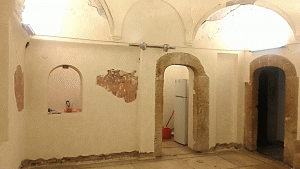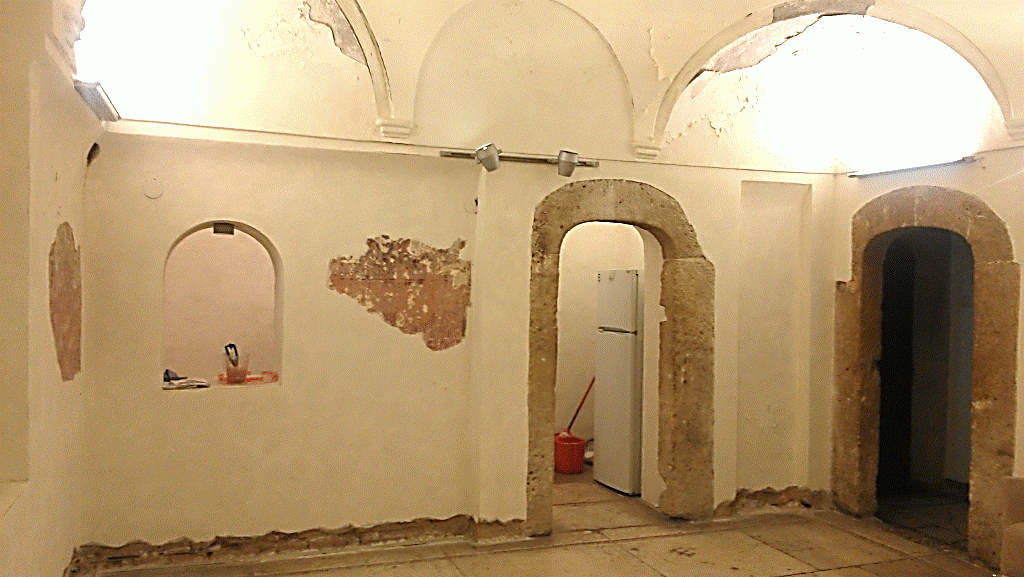Cross-posted from JohnFeffer.com. John is currently traveling in Eastern Europe and surveying its transformations since 1989.

The Turkish bath of Milos Obrenovic, now a bathroom and storage space for the Monument restaurant.
That’s been my experience with Serbia. The first encounter was certainly not auspicious. I first visited Belgrade in 1989, on my way south from Poland to the beaches of the Croatian coast. Or, at least, that’s where I thought I was heading. I arrived in Belgrade that July only to discover that all the bus and train tickets to Dubrovnik were sold out. During that summer, even with the Yugoslav economy in difficult straits, Dubrovnik remained a popular destination. Air tickets were available, but I didn’t have that kind of money. So, I ended up staying in Belgrade, disgruntled.
Belgrade seemed to me quite ugly, and I couldn’t wait to leave. I rescheduled my flight but still had to pass three days there. I could never get the hang of the city’s geography. Even with a map I was always getting lost. And everywhere I went I ran into the same two guys. Next to all the pictures of Tito hanging on the walls of restaurants and newsstands was this other fellow, Slobodan Milosevic, who looked like an apparatchik from central casting. I couldn’t wrap my head around all the signs that proclaimed “I [heart] Serbia.” I naively thought the creation of Yugoslavia had meant the death of nationalism. I obviously hadn’t been following recent events in the country.
My next visit to Belgrade was a 1990 flight with Yugoslav Air that passed through the country on the way to Poland. In those days, JAT was the cheapest way to get to Eastern Europe, but many of the flights with connections to points north required an overnight stay in Belgrade. On that particular night, we arrived late at night, near 10 pm, and were driven from the airport into the city to a reasonably nice three-star hotel. Sixty or seventy very hungry people crowded into the hotel lobby, waiting for the distribution of room keys. We waited. And waited. After an hour, it turned out that the hotel didn’t have rooms for us.
“Not to worry,” said our JAL representative. He packed us back into our bus, and we drove in the direction of the airport again. Near midnight, the bus stopped at a no-star hotel. Again we waited for an hour for our room keys to be distributed. The hotel had rooms for us, just not enough. I spent a restless night in a small room in a double bed with another guy, sleeping head to foot. Dinner that night was a huge platter of grilled meat that, because we were all ravenous, we tore into with abandon. There was plenty of alcohol to make us forget our ordeal and then, the next morning, to remember it in painful detail.
They woke us early enough to get to the airport three hours before our flights left. The airport wasn’t even open. I sat on a hard plastic seat and tried to sleep. Finally, it was time to check in.
“Ah,” said the young woman behind the counter, “you have to pay the airport tax.”
“Airport tax? No one had said anything about an airport tax.” I didn’t have any Yugoslav dinars, so I offered dollars.
“Oh no,” she said, “it has to be in dinars.”
“But the exchange booths aren’t open,” I pointed out.
She shrugged.
It turned out that I had a 15-minute window to exchange money, pay the tax, and, running with several other unhappy travelers, get onto the plane before it left. Goodbye and good riddance, I thought as Belgrade retreated into the distance.
An acquaintance later told me that she’d been in a similar situation at the Belgrade airport with one important difference: her early-morning flight left before the exchange booths opened. She waited until the last moment, walked up to the ticket-taking official, and threw a crumpled bill in his direction in lieu of the airport tax receipt. Then she ran through the turn style, down the ramp, and onto her plane just before they closed the doors. She became breathless all over again in the retelling, which made the improbable story believable.
Later that same year, I finally made it to Belgrade as part of my multi-country tour of the region. As soon as I arrived in the city, all of these bad memories flooded back. I had only one contact in the city. I called her up, interviewed her, and left for Zagreb the next day. There were even more pictures of Milosevic around, and the news of confrontations between Serbs and Croats in the Krajina region of Croatia were filtering in. Foreboding was thick in the air. The woman who owned the private flat where I was staying told me in a mix of Serbian and Russian that the Croatians were all fascists and the Albanians produced too many children. Civil society activist Sonja Licht, my one interviewee, provided me with an incisive critique of Milosevic and suggested that civil war had become increasingly likely. I couldn’t wait to leave.
Now, on my return to the region to retrace my steps, I’ve decided to start with Serbia. This might seem strange, since it’s the place where I talked to the fewest people. But I felt that I had been unfair to Belgrade. On a trip to the city a few years ago, I discovered that it wasn’t such a bad place after all. In fact, the pedestrian area in the downtown was charming and festive. I talked with artists and activists who were doing difficult and important work. But this visit in 2008 had also been brief, and I still felt that I hadn’t really seen Belgrade or Serbia.
I’ve already had several interesting encounters on this latest trip. I interviewed Sonja Beserko, once a member of the Yugoslav foreign ministry and long a sharp critic of authoritarian and nationalist politics. I ventured by bus to Pancevo, a suburb of Belgrade that NATO bombed repeatedly in 1999, to meet Sasa Rakevic, who writes comic strips under the name Alexander Zograf and published the wonderful book, Regards from Serbia. Later I’ll write more about these fascinating conversations along with a return visit with Sonja Licht.
But this Sunday I had a chance to wander around Belgrade and appreciate its intriguing tangle of streets. The city has been repeatedly destroyed over the years, by the Ottomans, the Austrians, and most devastatingly during World War II. Some buildings damaged during the 1999 bombing have been left standing as a reminder. Despite all this destruction, you can still find some lovely architecture – an art nouveau building, an old palace, an stately Orthodox church.
I had dinner at a restaurant called Monument, located in an addition to an old haram, or Turkish bath, that once was part of the extensive quarters of Milos Obrenovic. The placards hanging near the restaurant describe Obrenovic’s key role in Serbian history as a participant in the first uprising against Ottoman rule, a leader of the second uprising, and then a ruler who established the country as an autonomous dukedom.
Coincidentally, I was reading over dinner Helen Leah Reed’s 1916 book, Serbia: A Sketch. Just as I started in on my trout, I came upon the passage about Obrenovic. Reed adds something that the placards leave out: that Obrenovic had likely betrayed Serbian resistance leader Karadgordge to the Ottomans. So, it is fitting perhaps that all that remains of Obrenovic’s once vast estate – he was reputed to be one of the richest men of the Balkans – is this modest stone bathhouse, which now serves as a bathroom and storage facility for the restaurant.
Belgrade is not Prague. It’s not a beautiful city set up to accommodate tens of thousands of tourists. You have to work a little harder to appreciate the charms of the city. You have to dig a little to uncover its quirky history. But in the end, this struggle becomes perhaps this gritty city’s chief selling point.

